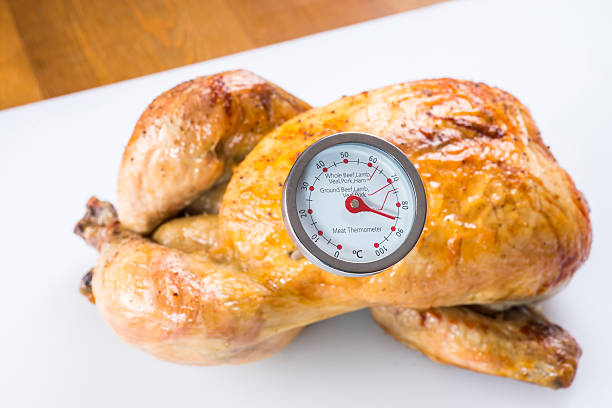There is nothing like the juicy, moist flavor of a perfectly roasted chicken. Whether you’re making it for Sunday dinner, Wednesday night taco bowls, or just to have deli-style chicken breast to munch on during the day, knowing how to choose and cook your poultry correctly is essential.
One of the major factors in order to ensure that your meal turns out perfectly cooked every time is using a good thermometer and checking the internal temperature of your chicken before serving it up! In this blog post we’ll discuss where exactly you should put your thermometer when taking readings so that you can enjoy a healthy and delicious meal with confidence.
Benefits Of Put Thermometer in Chicken:

1. Accurate Temperature Readings: Inserting a thermometer into the thickest part of your chicken will give you an accurate reading of its internal temperature, making sure that it’s cooked all the way through without being over-done or under-cooked and potentially causing foodborne illness.
2. Reduce Cooking Time: By checking the temperature of your chicken as it cooks, you can reduce cooking time by avoiding unnecessary overcooking. This is especially useful when roasting large birds like turkeys since they take more time to cook than smaller cuts of poultry.
3. Evenly Cooked Pieces: When using multiple pieces of poultry in one dish, taking temperature readings with a thermometer makes sure that all pieces are cooked to the same internal temperature and prevents you from having any under-cooked or over-cooked pieces.
Where is the Best Place to Put a Thermometer in a Chicken?
The best place to insert a thermometer into your chicken is in the thickest part of the breast. This will give you an accurate reading as to whether or not your poultry is cooked all the way through. Make sure that you avoid any bones, fat, and gristle when inserting the thermometer since these can provide false readings.
It’s important to remember that different types of poultry require different cooking times, so be sure to check with a reliable source for exact temperature guidelines. The USDA recommends that ground poultry should reach at least 165 degrees Fahrenheit and whole poultry should reach at least 165 degrees Fahrenheit in its innermost parts and 175 degrees Fahrenheit in its outermost parts.
Where to Put Thermometer Probe in Chicken Breast Meat?
When checking the temperature of chicken breast meat, it’s best to insert your thermometer into the thickest part of the breast. This will give you an accurate reading as to whether or not your poultry is cooked all the way through. As a rule of thumb, make sure that you avoid any bones, fat, and gristle when inserting the thermometer since these can provide false readings.
Where To Put The Thermometer In Chicken:
1. Thickest Part of Breast: Most people start by inserting their thermometer into the thickest part of the breast. This ensures that it’s getting an accurate reading since the breast is usually the last section to cook through, but it also allows you to check if other sections of your poultry have already reached a safe temperature.
2. Leg And Thigh Area: The leg and thigh area can be trickier as they tend to take longer to cook than other parts, so taking a temperature reading here will give you an accurate indication of when the rest of your bird is done.
3. Wings: Even though wings don’t take as long to cook, it’s still important to check their temperature with a thermometer to make sure they’re cooked all the way through.
How To Know If Chicken Is Done ?

The best way to know if your chicken is done is by taking a temperature reading with a thermometer. The USDA recommends that ground poultry should reach at least 165 degrees Fahrenheit and whole poultry should reach at least 165 degrees Fahrenheit in its innermost parts and 175 degrees Fahrenheit in its outermost parts. If the temperature is within these guidelines, then your chicken is safe to eat.
It’s important to remember that different types of poultry require different cooking times, so be sure to check with a reliable source for exact temperature guidelines before serving up any meals. Additionally, never rely solely on visual cues such as color or texture when determining whether or not your chicken is cooked through; always use a thermometer for the most accurate results.
When it comes to cooking poultry, a thermometer is an essential tool for making sure your food is cooked through and safe to eat. Taking temperature readings with a thermometer can help you get evenly cooked pieces and also lets you know when your chicken has reached the desired internal temperature so that you can feel confident when serving up meals. Keep these tips in mind and use a thermometer whenever possible to make sure that all of your poultry dishes are safely cooked!
How to Test Meat Thermometer?
Your meat thermometer is an essential kitchen tool and it’s important to make sure that its working properly. As such, you should test your thermometer regularly to ensure accuracy. Here are some simple steps for how to test a meat thermometer:
1. Fill a cup with crushed ice and add cold water until the ice cubes are just covered.
2. Insert the probe of your thermometer into the cup and wait several seconds for a reading.
3. Most digital thermometers should read 32F (0C). If not, adjust accordingly or consider replacing your thermometer if necessary.
4. For analog thermometers, place them in boiling water instead and look for a reading of 212F (100C).
Once your thermometer has been tested, you can be confident that it’s giving you reliable temperature readings and use it with peace of mind. However, keep in mind that all thermometers should be calibrated every few months to ensure accuracy.
How to Use a Meat Thermometer?
Using a meat thermometer is an easy and reliable way to make sure that your food is cooked safely. Here are some tips for how to use a meat thermometer:
1. Before inserting the probe into the food, preheat it in hot tap water. This will help ensure accuracy by bringing it up to temperature before taking readings.
2. Select the desired type and length of probe, then insert it into the thickest part of the food until it reaches its recommended depth as mentioned on product instructions.
3. Wait several seconds for a reading then remove the thermometer from the food and wipe off any juices or fat that could interfere with readings.
4. Read your results and remove the food from the heat if Internal Temperatures have been reached.
Following these tips can help you get accurate readings with your thermometer so that you can be sure your food is cooked properly. Remember, to always follow recommended temperature guidelines when cooking meats for safety.
Best Meat Thermometer to Use?
When it comes to selecting the best meat thermometer, there are a few factors to consider. Generally speaking, digital thermometers are more accurate and efficient than analog thermometers and should always be used when possible. Digital thermometers also tend to feature longer probes that can reach deeper into thick pieces of food for better readings.
Additionally, look for models with features like LCD displays for easy reading, programmable temperature settings for convenience or other advanced functions that may be useful in your kitchen.
What If I Don’t Have a Meat Thermometer?
If you don’t have a meat thermometer, there are a few other methods you can use to test the internal temperature of your food.
For example, try pressing on the surface of the meat with your finger; if it feels spongy and soft then it is likely not cooked through yet. Alternatively, try using a sharp knife to cut into the thickest part of the food and look at how cooked it appears inside. Ultimately, these methods aren’t as accurate as using a thermometer so whenever possible it’s best to invest in one for more reliable results!
FAQs:
What is the recommended internal temperature for poultry dishes?
The FDA recommends that poultry should be cooked to an internal temperature of 165F (74C) before it can be considered safe for consumption.
How often should I calibrate my thermometer?
Thermometers should be calibrated every few months to ensure accuracy. Refer to your product instructions for details on how to properly calibrate your thermometer model.
What other methods are available if I don’t have a meat thermometer?
If you don’t have a thermometer, you can try pressing on the surface of the food or cutting into it to test its doneness. Keep in mind, however, that these methods are not as reliable as using a thermometer.
What kind of thermometer should I use?
Digital thermometers tend to be more accurate and efficient than analog models and feature longer probe lengths for better readings. Look for additional features like LCD displays or programmable temperature settings for extra convenience in the kitchen.
Is chicken done at 165 or 180?
Chicken should be cooked to an internal temperature of 165F (74C) before it can be considered safe for consumption. Reaching 180F (82C) will result in a dry texture and overcooked dish.
Do you leave thermometer in chicken while cooking?
No, you should not leave a thermometer in the chicken while cooking. Insert the probe into the thickest part of the food until it reaches its recommended depth as mentioned on product instructions. Wait several seconds for a reading then remove it from the food before wiping off any juices or fat that could interfere with readings.
What should thermometer read for chicken?
The FDA recommends that poultry should be cooked to an internal temperature of 165F (74C) before it can be considered safe for consumption. Use a thermometer to check the chicken’s internal temperature in its thickest part before consuming. If the reading is at least 165F (74C), the chicken is safe to eat.
What temperature should I cook beef to?
The USDA recommends cooking beef steaks, roasts, and chops to an internal temperature of 145°F (62°C). Ground beef should reach an internal temperature of 160°F (71°C) before considering it safe to eat. Use a thermometer to check the internal temperature of your food to ensure safety and proper doneness.
The Bottom Line
Using a meat thermometer is one of the best ways to ensure your foods are cooked safely and thoroughly each time you prepare them. Selecting an accurate digital model with beneficial features can make testing internal temperatures quick and easy. Plus, following these tips will help guarantee reliable results every time! Be sure to always follow recommended temperature guidelines when cooking meats for safety reasons.

James Burney is the founder of Acadia House Provisions is a restaurant that with local & upscale dishes and high-quality kitchen supplies and food products. James was born and raised in Maine, and he has always been passionate about cooking. After working in a number of prestigious restaurants he started Acadiahouseprovisions.com with the goal develop into a comprehensive information site specializing in cooking and cuisine. His goal is to make it easy for people to cook delicious meals at home without spending a fortune.
